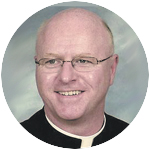
Msgr. Joseph Prior
(Readings of the Holy Mass – Solemnity of the Blessed Virgin Mary, the Mother of God)
Manger scenes are abundant in our churches and homes as we celebrate Christmas. There are also many images of the Holy Family on Christmas cards, calendars and paintings – even postages stamps. The art work serves as a reminder of what and more importantly who we celebrate. The images vary in size and shape, medium and color. One popular image of our Blessed Mother and the infant Jesus has her cradling the new born baby in her arms with Joseph standing behind her looking on in joy and love. The image is one we can readily relate to the scene as we see mothers and their babies in our families and among our friends. The scene stirs up in us an appreciation for and recognized need of familial love.
Another artistic visualization which we might consider of the Blessed Mother and Jesus is the famous statue of the Pieta by Michelangelo Buonarotti. The statue is located in Saint Peter’s Basilica in Rome. Michelangelo completed the statue in 1499. It is a large statue. The scene reflects the moment following Jesus’ death on the cross. He was taken down and placed in His mother’s arms. Mary is seated. The body of Jesus is on her lap. Her one arm holds him up. Life has been drained from his body. Mary gazes in love as she envelops her Son.
Many art historians will comment on the size of Mary in this image. Looking at the statue one may not notice, but she is very large and tall compared with the body of Jesus. In presenting the Pieta in this fashion, Michelangelo emphasizes the cradling of Jesus in his Mother’s arms. Prior to birth, Mary carried her son in her womb. After birth, she embraced the infant in her arms and fed him at her breasts. Now at his death she enfolds him, not only with her arms but her whole body.
[hotblock]
Our celebration of Christmas continues today with the Solemnity of Mary, Mother of God. The celebration invites us to reflect on the abundant blessings that flow to us through Jesus and Mary. The title of Mary for today’s celebration is “Mother of God.” It is a reminder to us that Jesus is God. He is the “Word,” who took on flesh and dwelt among us” (John 1:14). Saint John in his Prologue (John 1:1-18) begins with the eternal, before time, the realm of God. When he speaks of creation, he speaks of the Word being present. He will write: “all things came to be through Him and apart from Him nothing came to be.” (John 1:3) The passage starts with the memorable words: “In the beginning was the Word and the Word was with God and the Word was God.” (John 1:1) The “Word” is a reference to the Son of God who takes flesh through Mary.
Mary was chosen by the Father to be the woman who will give flesh to the Word. She nurtures him in her body as he matures until ready for birth. The role of nurturing continues along with feeding, clothing, teaching and forming her son, the Incarnate Word. The incarnation is truly mystery. The all powerful, all knowing, all loving, all merciful, eternal God takes flesh and is born among us. Mary’s role in God’s plan is essential and irreplaceable.
Our celebration is one of love and life. The love that God has for us. He comes to us as one of us to lead us to Him and to life. Mary plays no small part in making known His love. Her life is a “response” – she responds to love in love. When the angel Gabriel, speaking for the Father, asks her to take on this tremendous responsibility, she responds: “Let it be done according to your word.” (Luke 1: 38) Her “amen” is part of who she is. Her life is a continuous “amen” to God. A “yes” to Him and His love. She is there at the beginning of His earthly life and stays with Him to the end.
Divine life comes to us through Jesus Christ. He took on human life so that we might have eternal (divine) life. Saint Athanasius in his work On the Incarnation writes: “God became man so that man could become God.”
Saint Paul, in the passage from his Letter to the Galatians (second reading), reminds us that we become children of God through Christ Jesus. We are sons and daughters of the One God. As such, we share one Mother. Hence, Mary is also called the Mother of the Church.
The tender love she has for Jesus, she shares with all the children of God.
The images of the Blessed Mother mentioned above remind us of her loving embrace for her son.
This loving embrace she offers to all her children.
***
Msgr. Joseph Prior is pastor of Our Lady of Grace Parish, Penndel, and a former professor of Sacred Scripture and rector of St. Charles Borromeo Seminary.



Share this story